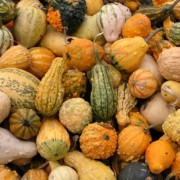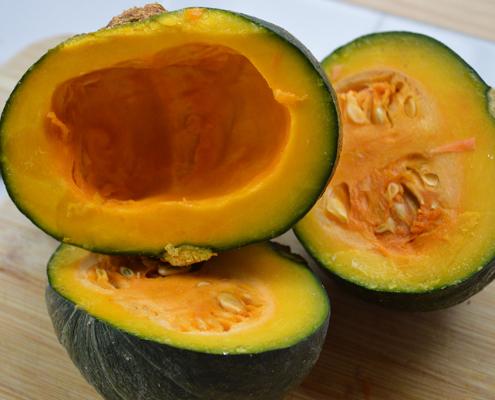The seasonal health benefits of local food just keep coming!
– By the Veggie Fairy Team
Many farmers markets shut down or scale back as temps drop, but not us. No way do we want to miss out on the superfoods of fall! They’re just now starting to hit their peak – the perfect excuse to gather in a warm, cozy kitchen on cool nights and enjoy these fall superfoods that are super-charged because they’re local and super fresh! Here’s what you can look forward to, along with recipe suggestions from our Pinterest boards:
Apples
Sweet or tart, raw or baked into a delicious dish, apples offer health benefits like heart-healthy flavonoids that you get when you eat the skin; antioxidants; and 4 grams of dietary fiber per serving. Harvest season: August-November. Try this recipe: Winter Apple Slaw
Brussels sprouts
With a mild, satisfyingly bitter taste, Brussels sprouts are great with tangy or savory sauces like balsamic vinegar. Health benefits include the fact that a half cup more than maxes out your daily recommended allowance of vitamin K, plus these sprouts are a good source of folate and iron. Harvest season: September-March. Try this recipe: Creamy Sprouts Gratin
Cauliflower
The sweet, slightly nutty flavor of cauliflower is delicious raw, steamed, or roasted. It can also be blended to create a mashed potato-like texture or pureed into soup. Among cauliflower’s health benefits are compounds that may help to prevent cancer and phytonutrients that may lower cholesterol. It’s also an excellent source of vitamin C. Harvest season: September–June. Try this recipe: Sticky Sesame Cauliflower Bites
Fennel
Looking like the love child of an onion and a dill plant, fennel tastes mildly like licorice and offers the health benefits of free-radical-fighting vitamin C, and potassium, which is essential for your heart, muscles, nerves, and kidneys to function properly. Harvest season: Fall through spring. Try this recipe: Fennel, Fontina & Onion Pizza
Parsnips
They look like pale carrots, and like carrots, parsnips are sweet — sweeter, actually, and nuttier. Eat them roasted on their own, or they go great with just about every other fall vegetable. For your good health, they’re rich in potassium and fiber. Harvest season: October-April. Try this recipe: Roasted Parsnips & Carrots
Pears
Crisp or tender, they’re all juicy and sweet and so delicious. Enjoy them raw, baked, or poached. They’re a good source of vitamin C and copper, of all things, and deliver 4 grams of fiber apiece. Harvest season: August-February. Try this recipe: Asian Pear Cranberry Stuffing
Pumpkins
What is fall without pumpkins?!! This queen of the winter squashes gets a category all its own, because it’s good for so much more than jack o’ lanterns and pies. This is another fall veggie whose health benefits include lots of potassium, plus tons of fiber and it’s a good source of B vitamins. Harvest season: October-February. Try this recipe: Pumpkin Chicken Tacos (just go easy on the jalapenos and tomatillos if you’re not into hot’n spicy!)
Rutabagas
Rutabagas are like a cross between a turnip and a parsnip, with an earthy flavor that’s delicious in casseroles. Or puree them with turnips and carrots to make a sweet soup, or roast them with ginger, honey, or lemon. However you eat them, you’ll get their health benefits of fiber and vitamin C. Harvest season: October-April. Try this recipe: Curried Rutabaga Soup
Spinach
Not just for Popeye, spinach is good raw in a salad or steamed or baked into other dishes. Cooking actually makes it easier for our bodies to digest its nutrients. The health benefits are so extensive we can’t list them all here! (Read them here.) Vitamins A, C, K, and iron, and a storehouse of disease-fighting phytonutrients are just the beginning. Harvest season: Year-round, but it gets sweeter after the first nip from Jack Frost. Try this recipe: Spinach & Mushroom Quinoa
Sweet potatoes
These veggies are good for so much more than Thanksgiving casseroles! Sweet potatoes are more nutritionally dense than white potatoes, with health benefits that include vitamin A, iron, and anti-inflammatory properties. Roast them like a potato, or cut up like fries. Harvest season: September–December. Try this recipe: Sweet Potato & Black Bean Chili
Turnips
Tender and mild, these root vegetables are a great alternative to radishes and cabbage. Flavor them with fennel, bread crumbs, or even brown sugar, or use them as a slightly bitter complement to the sweetness of parsnips and carrots. Turnip leaves, which taste like mustard leaves, are easy to steam or stir fry and are even denser in nutrients. The health benefits of the roots include vitamin C, while the leaves are rich in vitamins A, K, and folate. Harvest season: September–April. Try these recipes: Mashed Turnips with Bacon (because for the meat-eaters among us, everything’s better with bacon!) and Warm Turnip Green Dip
Winter squashes
Cool weather squashes are denser, finer, and sweeter than summer squashes, and their thick skins mean you can store them for months without much loss of flavor or nurtients. They contain heart-healthy omega-3 fatty acids (also good for kids’ brain health), are an excellent source of vitamin A, and taste even better with cinnamon and ginger, which have health benefits of their own. Harvest season: October–February. Try this recipe: Roasted Stuffed Winter Squash
ABOUT SEASONAL ROOTS
Since 2011, Seasonal Roots’ online farmers market has connected Virginia families with local family farmers who use sustainable, humane practices. Our veggie fairies – mostly moms who believe in living better through scrumptious, healthy eating, being kind to animals, protecting the environment, and spreading joy – home-deliver freshly harvested produce, pastured eggs, grassfed dairy and meat, plus artisan fare. We empower our members to eat better and live better with more nutritious, flavorful food that’s good for us and good for the planet. More info at seasonalroots.com.




